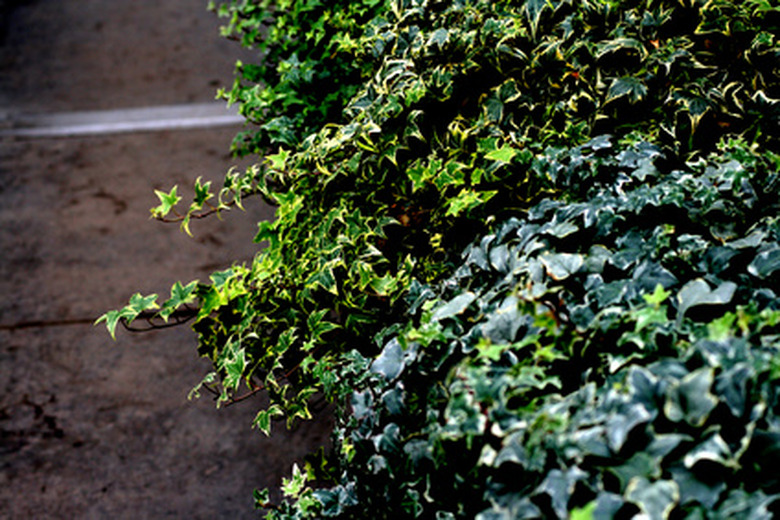How To Care For English Ivy In The Winter
English ivy (Hedera helix) is a fast-growing evergreen perennial that will add a lush, rich appearance to the landscape. Most often used as a ground cover, English ivy will soon grow into a thick, green carpet. The plant does especially well in cool, shady areas under tall trees where nothing else will grow. English ivy is a sturdy plant, but will benefit from protection in climates with cold winters.
Step 1
Prune English ivy by 1/3 to 1/2 of its height in autumn, using garden shears, hedge pruners or a lawn mower set on the highest setting. Leave at least 3 inches of the plant intact, as shearing the ivy too short can damage the plants.
Step 2
Water English ivy deeply before the ground freezes in winter, especially if the fall months have been dry. Watering is important, as wet soil will act as an insulator. Don't water the ivy if there is already snow or ice on the ground.
- English ivy (Hedera helix) is a fast-growing evergreen perennial that will add a lush, rich appearance to the landscape.
- Leave at least 3 inches of the plant intact, as shearing the ivy too short can damage the plants.
Step 3
Spread 2 to 3 inches of organic mulch such as straw or pine needles around the plants after the ground freezes. Mulch will protect the plants from damage caused by freezing and thawing. If the ivy isn't protected by a snow cover, lay evergreen boughs over the plants. Boughs from a Christmas tree work very well.
Facts About English Ivy
English ivy, an evergreen perennial climbing or trailing vine, is hardy in U.S. Department of Agriculture plant hardiness zones 5 through 11. This aggressive climber attaches to surfaces via root-like structures that excrete a sticky, gluey substance. Some cultivars display unlobed leaves, while others have leaves with three or five lobes. English ivy fruits are dark blue or black with a fleshy outer layer and stone-like seeds; they can be poisonous to people and pets. An import from Europe, the plant now thrives in much of the Pacific Northwest, the West Coast and most of the eastern United States. The aggressive grower has no natural checks and can climb over anything in its path. Vines climbing up trees can be cut a few feet from the ground, for convenience, to kill upper portions before hand-removing the lower portions.
- English ivy, an evergreen perennial climbing or trailing vine, is hardy in U.S. Department of Agriculture plant hardiness zones 5 through 11.
- The aggressive grower has no natural checks and can climb over anything in its path.
Facts About English Ivy
English ivy, an evergreen perennial climbing or trailing vine, is hardy in U.S. Department of Agriculture plant hardiness zones 5 through 11. This aggressive climber attaches to surfaces via root-like structures that excrete a sticky, gluey substance. Some cultivars display unlobed leaves, while others have leaves with three or five lobes. English ivy fruits are dark blue or black with a fleshy outer layer and stone-like seeds; they can be poisonous to people and pets. An import from Europe, the plant now thrives in much of the Pacific Northwest, the West Coast and most of the eastern United States. The aggressive grower has no natural checks and can climb over anything in its path. Vines climbing up trees can be cut a few feet from the ground, for convenience, to kill upper portions before hand-removing the lower portions.
- English ivy, an evergreen perennial climbing or trailing vine, is hardy in U.S. Department of Agriculture plant hardiness zones 5 through 11.
- The aggressive grower has no natural checks and can climb over anything in its path.
Things Needed
- Hedge pruners or a lawn mower
- Mulch
- Evergreen boughs
Warning
English ivy can be aggressive, and if not controlled can do serious damage to the natural environment. To prevent the plant from becoming invasive, keep English ivy maintained and within its boundaries. If you haven't yet planted English ivy, consider planting it in containers.
References
- Ohio State University: Hedera helix – English Ivy
- Yardener.com: English Ivy
- National Park Service: English Ivy
- California Invasive Plant Council: Invasive Plants of California's Wildland: Hedera Helix
- King County, Washington: Noxious Weeds: English Ivy
- National Park Service: English Ivy
- California Invasive Plant Council: Invasive Plants of California's Wildland: Hedera Helix
- King County, Washington: Noxious Weeds: English Ivy
